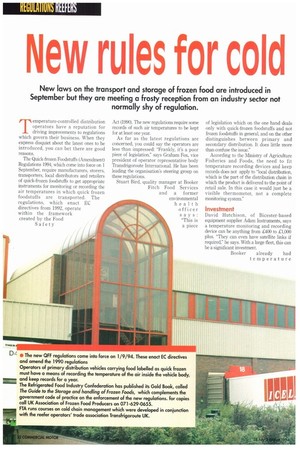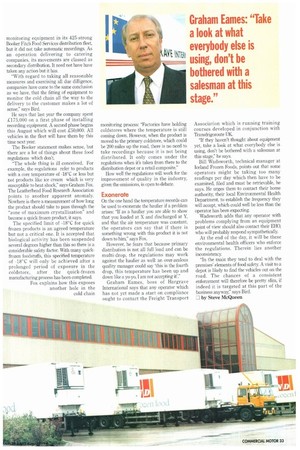New rules for cold
Page 34

Page 35

If you've noticed an error in this article please click here to report it so we can fix it.
New laws on the transport and storage of frozen food are introduced in September but they are meeting a frosty reception from an industry sector not normally shy of regulation.
Temperature-controlled distribution operators have a reputation for driving improvements to regulations which govern their business. When they express disquiet about the latest ones to be introduced, you can bet there are good reasons.
The Quick-frozen Foodstuffs (Amendment) Regulations 1994, which come into force on 1 September, require manufacturers, storers, transporters, local distributors and retailers of quick-frozen foodstuffs to get appropriate instruments for monitoring or recording the air temperatures in which quick frozen foodstuffs are transported. The regulations, which enact EC directives from 1992, operate within the framework created by the Food Act (1990). The new regulations require some records of such air temperatures to be kept for at least one year.
As far as the latest regulations are concerned, you could say the operators are less than impressed: "Frankly, it's a poor piece of legislation," says Graham Fox, vice president of operator representative body Transfrigoroute International. He has been leading the organisation's steering group on these regulations.
Stuart Bird, quality manager at Booker Fitch Food Services and a former environmental health officer says: "This is a piece of legislation which on the one hand deals only with quick-frozen foodstuffs and not frozen foodstuffs in general, and on the other distinguishes between primary and secondary distribution. It does little more than confuse the issue."
According to the Ministry of Agriculture Fisheries and Foods, the need to fit temperature recording devices and keep records does not apply to "local distribution, which is the part of the distribution chain in which the product is delivered to the point of retail sale. In this case it would just be a visible thermometer, not a complete monitoring system."
Investment
David Hutchison, of Bicester-based equipment supplier Adam Instruments, says a temperature monitoring and recording device can be anything from £400 to £1,000 plus. "They can even have satellite links if required," he says. With a large fleet, this can be a significant investment.
Booker already had temperature monitoring equipment in its 425-strong Booker Fitch Food Services distribution fleet, but it did not take automatic recordings. As an operation delivering to catering companies, its movements are classed as secondary distribution. It need not have have taken any action but it has.
"With regard to taking all reasonable measures and exercising all due dilligence, companies have come to the same conclusion as we have, that the fitting of equipment to monitor the cold chain all the way to the delivery to the customer makes a lot of sense," says Bird.
He says that last year the company spent 1175,000 on a first phase of installing recording equipment. A second phase begins this August which will cost £50,000. All vehicles in the fleet will have them by this time next year.
The Booker statement makes sense, but there are a lot of things about these food regulations which don't.
"The whole thing is ill conceived. For example, the regulations refer to products with a core temperature of -18'C or less but not products like ice cream which is very susceptible to heat shock," says Graham Fox. The Leatherhead Food Research Association points to another apparent anomaly. Nowhere is there a measurement of how long the product should take to pass through the "zone of maximum crystallisation" and become a quick frozen product, it says.
The specified limit of -18°C for quick frozen products is an agreed temperature but not a critical one. It is accepted that biological activity has been suspended several degrees higher than this so there is a considerable safety factor. With many quickfrozen foodstuffs, this specified temperature of -18°C will only be achieved after a prolonged period of exposure in the coldstore, after the quick-frozen manufacturing process has been completed. Fox explains how this exposes another hole in the cold chain monitoring process: "Factories have holding coldstores where the temperature is still coming down. However, when the product is moved to the primary coldstore, which could be 200 miles up the road, there is no need to take recordings because it is not being distributed. It only comes under the regulations when it's taken from there to the distribution depot or a retail composite."
How well the regulations will work for the improvement of quality in the industry, given the omissions, is open to debate.
Exonerate
On the one hand the temperature records can be used to exonerate the haulier if a problem arises: "If as a haulier you are able to show that you loaded at X and discharged at Y, and that the air temperature was constant, the operators can say that if there is something wrong with this product it is not down to him," says Fox.
However, he fears that because primary distribution is not all full load and can be multi-drop, the regulations may work against the haulier as well: an over-zealous quality manager could say 'this is the fourth drop, this temperature has been up and down like a yo-yo, I am not accepting if."
Graham Eames, boss of Hargrave International says that any operator which has not yet made a start on compliance ought to contact the Freight Transport Association which is running training courses developed in conjunction with Transfrigoroute UK.
"If they haven't thought about equipment yet, take a look at what everybody else is using, don't be bothered with a salesman at this stage," he says.
Bill Wadsworth, technical manager at Iceland Frozen Foods, points out that some operators might be taking too many readings per day which then have to be examined, filed and must be retrievable, he says. He urges them to contact their home authority, their local Environmental Health Department, to establish the frequency they will accept, which could well be less than the operator has been expecting.
Wadsworth adds that any operator with problems complying from an equipment point of view should also contact their EHO, who will probably respond sympathetically.
At the end of the day, it will be these environmental health officers who enforce the regulations. Therein lies another inconsistency.
"In the main they tend to deal with the premises' elements of food safety A visit to a depot is likely to find the vehicles out on the road. The chances of a consistent enforcement will therefore be pretty slim, if indeed it is targeted at this part of the business anyway" says Bird.
by Steve McQueen




































































































